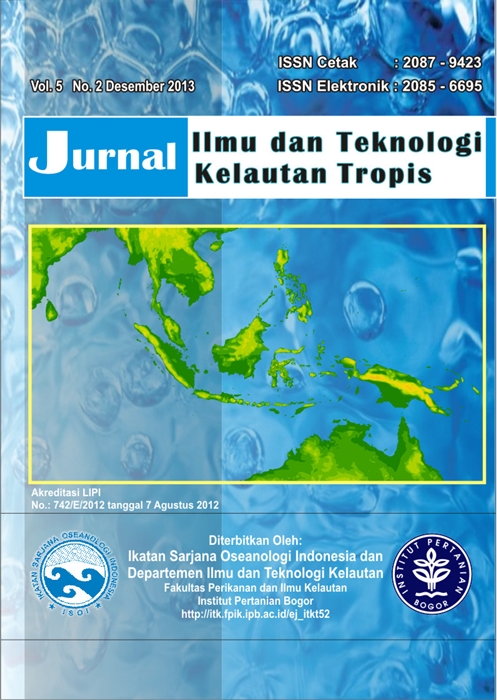THE COMPOSITION OF SPESIES AND CHANGES IN REEF FISHES COMMUNITY AT ECOREEF REHABILITATION SITE, MANADO TUA ISLAND, BUNAKEN NATIONAL PARK
Abstract
The study conducted from 2006 to 2012 with an interval of every two years in the ecoreef area of Manado Tua island found 2,936 individual reef fishes of 181 species that include into 32 families. Species composition value of the 10 dominant species of reef fishes was 55.48% of the total species. The highest number of species was Plotosus lineatus with schooling behavior which only discovered in 2010 at a depth of 3 meters. Ecoreef area of Manado Tua island, when analyzed from the abundance and biomass of reef fishes exhibited a succession of reef fish that have been stable, with peak abundance and higher biomass in 2008 and 2010. Reef fish found in ecoreef seemed to start a new living and become a new habitat for them. These were indicated by the highest biomass during the previous year but the number of individuals and spesies were decline. There was no change in the structure of reef fish communities in the ecoreef area of Manado Tua Island, which characterized by non significant different ecological index between the years. Cluster analyses grouped reef fish species into 2 groups i.e., the group of 2006 and the group of 2008, 2010, and 2012. Early survey in 2006 showed lower abundance of reef fish species for allegedly associated with low ecoreef organisms.
Keywords: ecoreef, spesies composition, community structure, reef fish.
Authors
This work is licensed under a Creative Commons Attribution 4.0 International License.
Jurnal Ilmu dan Teknologi Kelautan Tropis i is an open-access journal, meaning that all content is freely available without charge to the user or their institution. Users are allowed to read, download, copy, distribute, print, search, or link to the full texts of the articles in this journal without needing to request prior permission from the publisher or the author.
All articles published by Jurnal Ilmu dan Teknologi Kelautan Tropis are licensed under the Creative Commons Attribution 4.0 International License. This allows for unrestricted use, distribution, and reproduction in any medium, provided proper credit is given to the original authors.
Authors submitting manuscripts should understand and agree that the copyright of published manuscripts is retained by the authors. Copyright encompasses the exclusive rights of authors to reproduce, distribute, and sell any part of the journal articles in all forms and media. Reproduction of any part of this journal, its storage in databases, and its transmission by any form or media is allowed without written permission from Jurnal Ilmu dan Teknologi Kelautan Tropis.


